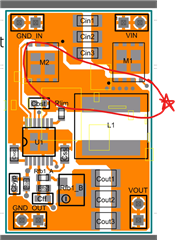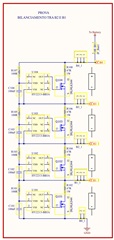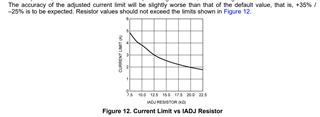Other Parts Discussed in Thread: INA226, LM22673, LM22679, CSD18537NQ5A, CSD18504Q5A, LM5117, LM5166, LM25018
Good morning,
I have been using the Buck converter LM3150 for some time for many of my projects, where however the spaces are usually larger.
This time, however, the size of the card forces me to use a more "restrictive" layout.
I followed the Webench project which suggested the following to me (if you need the P/Ns suggested by Webench I'll pass them on to you)
/resized-image/__size/1739x889/__key/communityserver-discussions-components-files/196/2_5F00_1schematic.jpg
Unlike the original Webench scheme I only divided the feedback resistor Rfb1 with 2 resistors, one fixed and one with a potentiometer which, being of necessity
SMD size (Burns 3224W series) is only 12 turns and therefore to obtain a conversion value the as close as possible to the desired I need to decrease the resistive
value of the trimmer by putting a resistor in series.
The buck converter values will be as follows:
Vin : 13.2 - 28V
Vout: 12.06V
Imax : 10A
Soft start: 4ms
Frequency: ~ 474kHz
I attach you below:
- The Outline
/resized-image/__size/707x1064/__key/communityserver-discussions-components-files/196/3_5F00_outline.jpg
- The Top Layer (the orange is the copper of the TOP, I also marked the paste in gray (because I couldn't show the PADs well) and in black the outline with
the component references).)
/resized-image/__size/3297x4945/__key/communityserver-discussions-components-files/196/4_5F00_top.jpg
- Inner Layer 1 (the orange is the copper of the internal side 1, I also marked the VIAS in gray and the outline in black with the refs of the components present
at the TOP in those areas)
/resized-image/__size/707x1064/__key/communityserver-discussions-components-files/196/5_5F00_inner1.jpg
- Inner Layer 2 (the orange is the copper of the internal side 2 which is entirely GND lake, I also marked the VIAS in gray and the outline in black with the references
of the components present at the TOP respectively in those areas)
- The Bottom Layer (the orange is the copper of the internal side 2 which is entirely GND lake, I also marked the VIAS in gray and the outline in black with the
references of the components present at the TOP respectively in those areas)
To carry the 10A I preferred to make it in 4 layers of which:
- inner 2 (18um copper) and the Bottom (35um copper) entirely dedicated to GND
- Top (35um copper) and Inner 1 (18um copper) dedicated to the positive and signal tracks.
I have often read to put at least 1 full side of GND so I also passed the signals on the MOSFET gates to Inner 1 or to the TOP.
I added some Vias on the inductance pads to increase its dissipation on the internal layer and the same thing under the thermal pads of the 2 mosfets in order
to increase the copper on the internal side.
Now the questions:
1) do you think the layout is fine and does not create problems? (I tried to put all the capacitors and resistors as close to the controller as possible)
2) I could also make the PCB 6 or 8 layers by simply duplicating the inner 1 and the inner2 each 2 more times towards the inside so as to have 4 sides for the
positive signal and 4 sides for the GND. Could it help or could it cause problems?
3) among the options given by Webench it initially suggested the 4.7uH inductance that he suggests for the 6.8uH XAL1010-682MEB inductance, do you think it's good?
Because I wouldn't want the inductance to heat up unnecessarily if the load was much lower than that for which I assumed its use (since the use was designed for
multi-purpose purposes, i.e. both for "low" load applications 2-3A,both for applications with 8-9A load)
4) I had a doubt, does the LM3150 have DCM (Discontinuous Conduction Mode) ? Because I didn't find it on the datasheet by doing a search.
5) do you have any suggestions for the future of some tracks or signals that absolutely must not pass through certain areas?
Thanks everyone in advance
Paolo

































